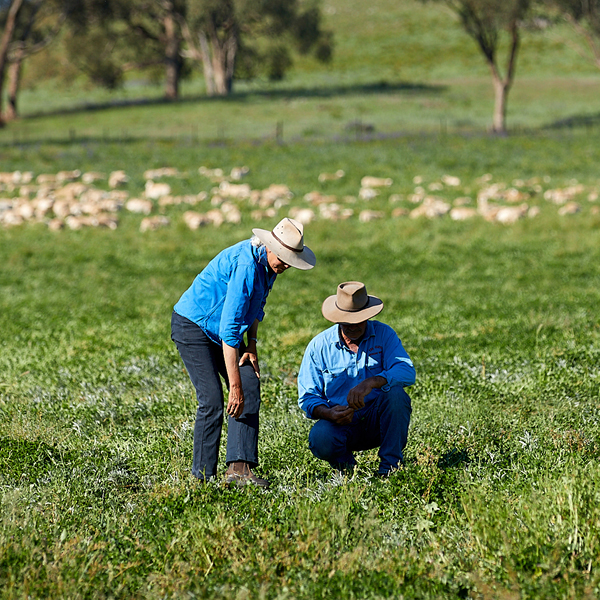Listen to the recording here:
Find out how industry partnerships are being used to tackle some of industry’s big complex issues whilst contributing to doubling the value of red meat sales and positioning Australia as a trusted source of protein through its sustainability investments.
Read the Q&As from the panel session:
Questions that were answered live during the webinar (please refer to recording above to hear the answers)
- We know there are costs to sustainability, but what are the income benefits? Are there plans for a retail premium to be passed back along the supply chain to the producer?
- The system-wide collaborative approach is terrific. Who orchestrates this – is that MLA, are there 'prime partners'?
- Very interested in the Sheep Reproductive Strategic Partnership. I’m wondering if this work is also looking at differences in performance between breeds?
- Where’s the best bang for buck in the market for carbon credits now and in the future?
- What’s the beef with methane from cattle? Aren’t they part of a natural cycle and we have nothing to worry about?
- What is happening with southern beef research? I think we invested in two programs - one with SA doing work on heifer management, one with Mckinnon looking at herd performance?
- How much of the supply chain will be covered by the CN30 program? Will products be carbon neutral up until the animal hits the abattoirs or will the abattoirs themselves be covered?
Questions taken on notice and answered following the webinar
- Are there measures of current adoption of carbon neutral practices among producers?
Yes, industry-level adoption is reflected in progress shown in the National Greenhouse Gas Inventory. Individual producer-level adoption is monitored through engagement through MLA’s adoption products including Producer Demonstration Sites, Profitable Grazing Systems, and EDGE. - What is the first practical step to establishing a carbon account – where to go?
Check out the accounting tools on MLA’s website - https://www.mla.com.au/news-and-events/industry-news/creating-a-carbon-account-for-your-business/ - I assume that net zero emission target refers to scope 1 and 2. Do you think it is the responsibility of our industry to influence the scope 3s, particularly towards consumers, or is this too hard?
The emissions scope under the CN30 Initiative covers Scope 1, 2 and 3 emissions. You can read more in the CN30 Roadmap https://www.mla.com.au/globalassets/mla-corporate/research-and-development/program-areas/environment-and-sustainability/2689-mla-cn30-roadmap_d3.pdf. Acton on climate change is everyone’s responsibility. - Are there grants available for processors to develop carbon neutral products?
Yes. State and Commonwealth Government opportunities exist right now. Opportunities exist to partner with MLA as well. Check out https://www.mla.com.au/about-mla/what-we-do/mla-donor-company/ - For branded beef products to claim CN, who manages this certification? Are there farm audit processes in place to ensure compliance?
Various accreditation and certification schemes exist, including the Commonwealth Government’s Climate Active certification. An audit process is involved. - What might happen if the industry doesn’t achieve CN30?
The consequence will likely be determined by the state of consumer sentiment towards industry, and government policy, in 2030. The risk of not demonstrating commitment to reducing global warming is that public trust in the industry could decline and the heavy hand of regulation may be imposed. The red meat industry’s contribution to temperature rise could climb as other sectors take action to reduce their contribution. Our global competitors, including Brazil and New Zealand, are working towards carbon neutral red meat production. Meanwhile some parts of the world are calling for a tax on red meat. Industry-led initiatives ensure industry is in the driver’s seat and is recognised for leading the world in the development and delivery of climate-friendly food production. - Reporting from Red Meat Green Facts, it would be useful to have sources for the facts to provide more rigor. What responses have you had to the booklet?
All the facts contained within Red Meat, Green Facts are checked and sourced to ensure credibility and rigor. Since launch in May, MLA has distributed 55,000 hard copy booklets to stakeholders and the Red Meat, Green Facts website has received over 30,000 views. - How important are the beef and sheep sustainability frameworks in reporting our progress in sustainability and welfare to customers and stakeholders?
The Australian Beef and Sheep Sustainability Frameworks have been developed by the Australian beef and sheep industries to meet the changing expectations of customers, consumers, investor and other external stakeholders.
This is achieved by identifying opportunities for the beef and sheep industries to improve their sustainability credentials, through transparently tracking performance against critical industry priorities with accurate and current data.
It is critical that the Frameworks are industry led, only industry and its producers have the unique knowledge and understanding of the land, natural resources and animals and only industry and its producers can implement that practice changes required to defend out market access, social licence and ability to operate.
Additional resources:
|
Topic |
Resources |
|
Productivity and animal wellbeing Presented by David Beatty |
|
|
Environmental stewardship – CN30 Presented by Doug McNicholl |
|
